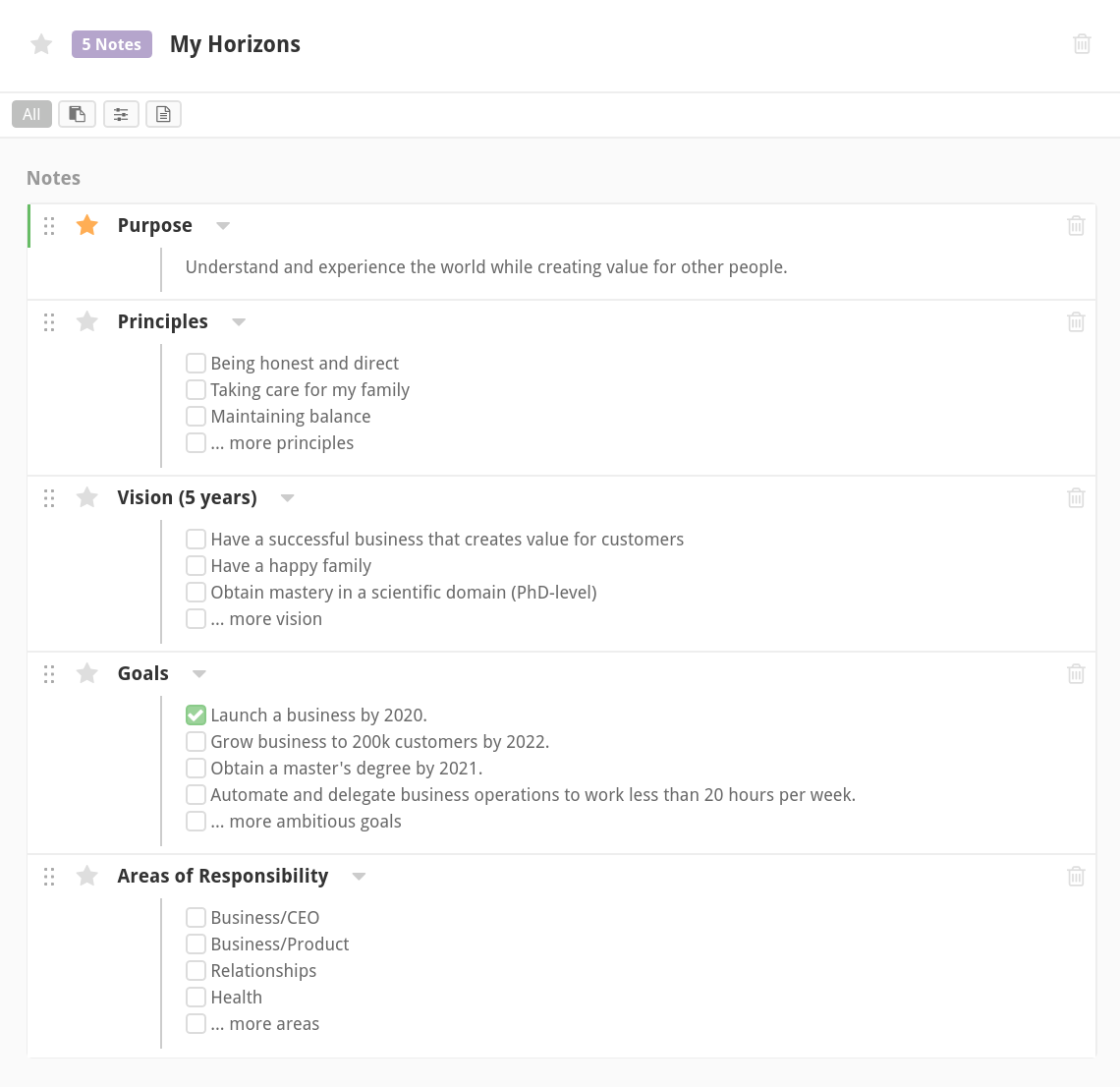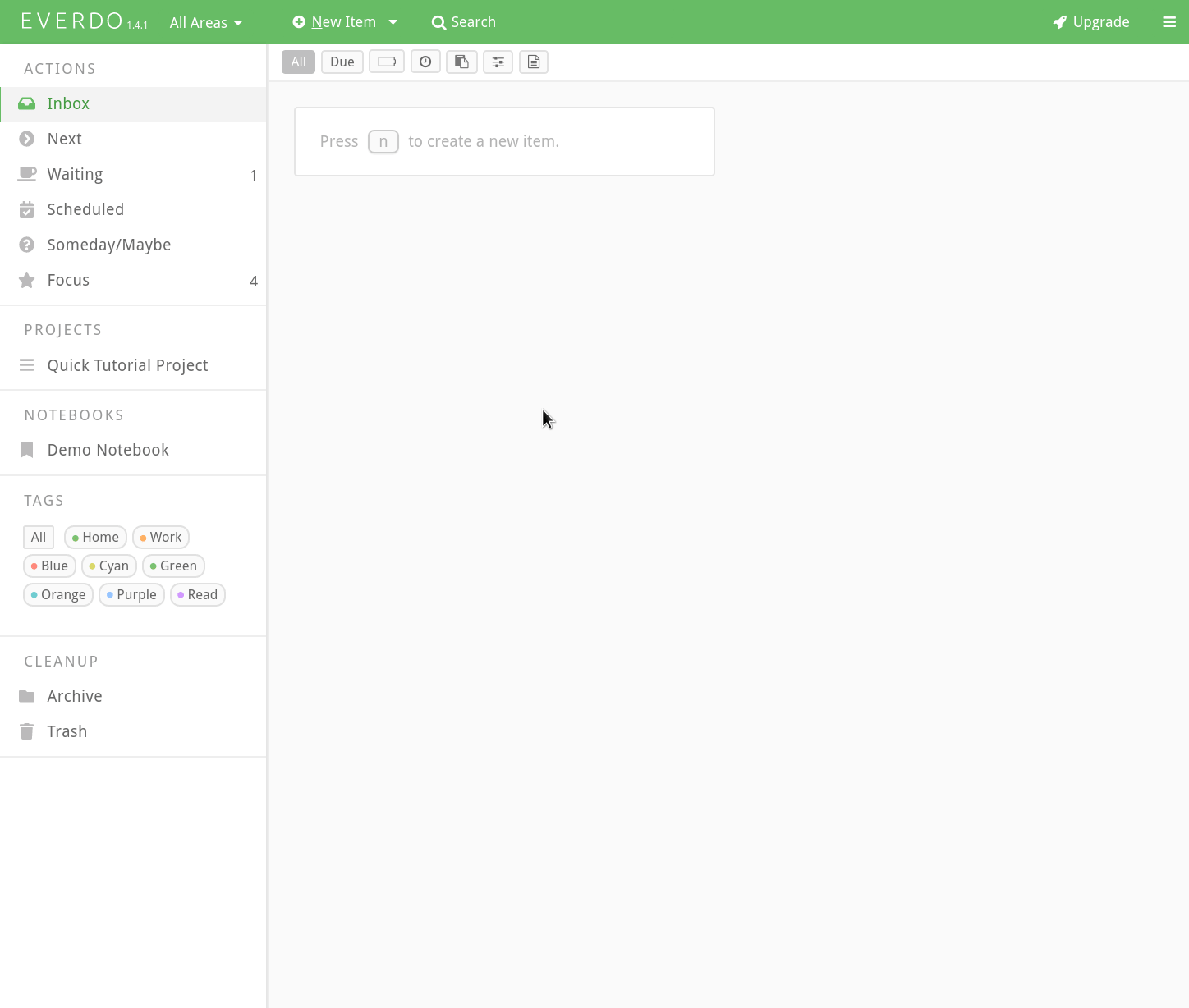Horizons: A Framework For Gaining Clarity And Direction in Work and Life
Your time is limited. Wouldn't it be nice to always know that you are spending it optimally, working on what matters most? A key tool for achieving such clarity is the system of Horizons of focus. It helps you get your goals and commitments in line so that you can focus on execution without worrying. In this post we explore what the Horizons are and how you can define them in Everdo.
Introducing the six horizons
Each horizon represents a certain level of perspective. These levels cover the whole range of the scale from high-level values all the way to daily tasks. Here are the specific horizons introduced in Getting Things Done.
- Purpose and Principles
- Vision
- Goals
- Areas of responsibility
- Projects
- Actions
Defining each of these horizons for yourself will help prioritize work and align your goals. Even more importantly, it may lead you to discard commitments that you don't care about very much. This will free up time for the really important projects and activities.
Now let's go over each of the horizons.
Level 1, Purpose and Principles: what is your destination in life?
Your purpose is why you exist in this world. You can also think of it as your personal mission statement in life. A purpose gives meaning and context to all your goals and projects. Particularly it will help you define the lower-level horizons, since they exist precisely to help you fulfill your purpose.
I think that purpose is the most difficult concept to define out of everything this post discusses. It can take many attempts and years of reflection to discover your true purpose. So don't worry too much if your purpose is not obvious to you right now. Do your best to write it down and revise later as necessary. This goes for other horizons as well.
Purpose goes hand in hand with principles. Principles are the standards that you aim to meet while fulfilling your purpose. You can also think of them as values. Principles will put constraints on the ways you set and achieve your goals. Some examples of principles include
- being honest
- taking care for your family
To get full benefit from the concept of principles, try to only include the ones that you really care about.
Level 2, Vision: where are you in five or more years?
To define your vision means to answer the question "Where do you see yourself in five years, having achieved your goals?". How does your work look like? Where do you live? What about your family and relationships? Think about your long-term plans and aspirations in life - these make up your vision.
One tip I have for defining this horizon is to think big and actually envision big success. This attitude can get you to aim higher with your goals and force you to cut down on distractions down the road to your purpose.
Level 3, Goals: your big targets for the next few years
The concept of a goal doesn't need much introduction. In the context of horizons of focus, goals are your objectives on the time scale of several months up to a few years from start to finish.
Goals are somewhat similar to projects, which we will define later. The major difference is that goals tend to be more stable and oriented at fulfilling your vision, while projects occur in the moment as needed. It follows that you don't need to re-evaluate goals often, whereas you want to review your list of projects at least weekly.
Note that, as with any goals, it's important to make your GTD goals SMART - specific, measurable, achievable, relevant, and time-bound.
Before trying to list your goals, it may be helpful to read about the next horizon of focus - areas of responsibility. This is because thinking about each area of responsibility can trigger your mind into coming up with the corresponding goals.
Level 4: Areas of responsibility: what are your roles?
You can think of areas of responsibility as the list of all the "hats" you wear. In other words, these are the roles that you play as part of your work and personal life. Some examples might include
- Being a parent or a husband
- Taking care of the house
- Maintaining good health
- Being a manager on your team
- Other major roles in your job description
The act of explicitly defining your areas of responsibility can be a very rewarding experience. It clarifies the areas where you don't focus as much as you should in order to fulfill your vision.
When you are listing your areas of responsibility, it's also useful to think why you have each one of them. How does a given responsibility relate to your goals and vision? Should you be responsible for this at all? Can you delegate or drop it altogether? Asking these questions will help you approach your responsibilities mindfully. It will drive you to avoid taking on unnecessary responsibilities that will only distract you from your goals.
In one of the future posts I will describe how to use your areas of responsibility to create a personal trigger list that will simplify the Weekly Review.
Level 5, Projects: the short-term outcomes you are working towards
In Getting Things Done a project is any desired outcome that takes more than one action to accomplish. You can think of a project as a relatively small goal on the scale of a a few hours to a few weeks.
You create projects as they come up as part of your responsibilities, or as part of the your long-term goals. For example, things like "Publish a blog post", "Learn GTD principles" could be considered projects consisting of more than one action.
Unlike the horizons that we have covered so far, projects are the core of your day-to-day work, so they are treated specially by the GTD method, and therefore by Everdo. You can learn more about this on the projects documentation page.
If you are just getting started with GTD, then you don't need to define your projects right now. Instead, follow the usual GTD steps of collect > process > organize, which will lead you to creating projects as they come up. Keep in mind that Getting Things Done has important principles that must be followed in order to make your list of projects actionable and useful. We well cover these rules in depth in future posts.
Level 6, Actions: the actual tasks that you need to do
Actions are the specific tasks that you can immediately start executing given the right conditions (context, time, energy). An action can be a part of a project, or it can be standalone.
Same as projects, actions don't need to be listed when defining your horizons. Instead, you will create actions naturally while following Getting Things Done. The reason we have included projects and actions in this article is to show the complete hierarchy of horizons from top to bottom.
Creating your horizons in Everdo
When practicing GTD, you will engage with your actions and projects constantly. This is why Everdo has many tools and features aimed to simplify working with actions and projects, such as Scheduling, Tagging, Filtering and more.
On the other hand, the higher-level horizons are much more stable, requiring only an occasional review. Because of this, I think it's sufficient to keep the list of high-level horizons either in your reference system, or in an Everdo notebook.
Here is an example of what a Horizons notebook might look like in Everdo.

The animation below demonstrates how to begin creating your horizons in Everdo.

Using and reviewing the list of your horizons
You can think of the horizons as your real, stable priorities that you have thought through. This makes them useful anytime there is doubt or internal conflict about prioritizing your projects or taking up new commitments. By keeping your list of horizons handy you can keep on course when confronted with a constant stream of input and opportunities in your life.
Another way to utilize your list of horizons is by setting up a review process. After you have defined your purpose, principles, vision, and goals, you should aim to review them approximately once every quarter.
For each goal/vision/principle you should
- make sure that it is current and still relevant to you
- ask yourself whether you are making sufficient effort and progress towards achieving the target
- ask yourself what block or distracts you from making progress
When it comes to reviewing areas of focus, I suggest doing it weekly as part of your Weekly Review of the whole system. We will cover the weekly review in depth in one of the future posts.
Conclusion
Now you know the basics about horizons of focus. I hope this post helps you utilize this concept as a framework to gain focus and direction consistently. Make sure you take some time to define your high-level horizons in Everdo and review them from time to time. Remember that it's a crucial part of the Getting Things Done method.
If you have any tips or insight on using the horizons of focus technique, please comment below.
- Try Everdo for free and start getting your tasks under control.
- Subscribe to get more articles like this one.